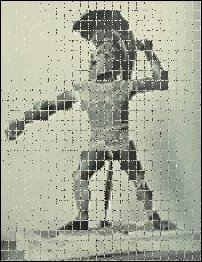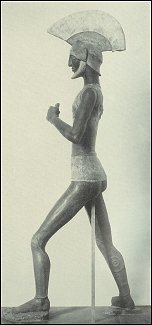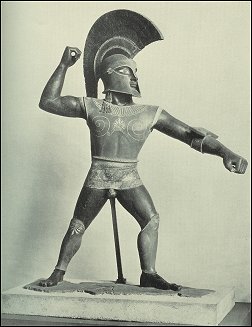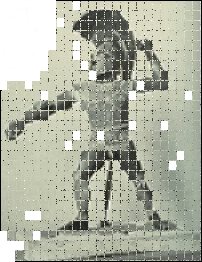 This is the story of a gigantic (so to speak) scholarly “oopsie”-
This is the story of a gigantic (so to speak) scholarly “oopsie”-In late 1915 Gisela Richter, renowned expert on Greek and Roman antiquities at New York’s Metropolitan Museum of Art, received a letter from John Marshall, the Museum’s veteran purchasing agent in Italy, describing a newly discovered life-size Etruscan warrior figure in terra-cotta which had been discovered in an Italian field.
 The “old warrior” (he had a white beard and was emaciated, somewhat like, as one observer commented later, a Giacommetti sculpture) was soon followed by a massive four-foot tall terra cotta warrior’s head, and there was even talk of a greater treasure waiting to be found...
The “old warrior” (he had a white beard and was emaciated, somewhat like, as one observer commented later, a Giacommetti sculpture) was soon followed by a massive four-foot tall terra cotta warrior’s head, and there was even talk of a greater treasure waiting to be found...It was, of course, all fakery, carried out on a grand, almost “mythic” scale, a scale meant to make experts put aside all their nagging doubts and see the “Etruscans” as what they were not (namely, ancient). The white-bearded warrior and the massive head had been created by Riccardo Riccardi and Alfredo Fioravanti, two young men of skill and a certain vision. Riccardo’s father and brothers had also specialized in historic pottery, but Riccardo was the true genius of the family. With his friend Alfredo he first created the anorexic, white-bearded warrior.
The figure was modeled as one piece and then broken up into 24 fragments for firing, as the kiln was not large enough to accomodate the entire figure. The warrior is missing his right arm for the simple reason that the two forgers could not agree on how to position the arm, so they compromised by breaking it off and discarding it.
 After selling the figure to the Metropolitan, the pair began work on another figure, this time a gigantic warrior's head. Working from a description by Pliny of a 25-foot tall statue of Jupiter in a Roman temple, the pair made the head four and a half feet tall. This was broken into 178 pieces, fired, and shipped off to the Met. And then Riccardo and Alfredo had to leave to serve their time in the Italian Army.
After selling the figure to the Metropolitan, the pair began work on another figure, this time a gigantic warrior's head. Working from a description by Pliny of a 25-foot tall statue of Jupiter in a Roman temple, the pair made the head four and a half feet tall. This was broken into 178 pieces, fired, and shipped off to the Met. And then Riccardo and Alfredo had to leave to serve their time in the Italian Army.When they returned they began their most audacious project yet- a Colossal Warrior in terra cotta, standing over eight feet tall. Then tragedy struck. Riccardo was killed in a fall from his horse that winter, and his place was taken by two less-skilled cousins. As with the earlier pieces, the statue had to be fired in pieces as it was much too large for the kiln.
It proved, in fact, to even be too large for the room it was being modeled in, and by the time they had modeled up as far as the waist it was obvious that the elegant classical proportions of genuine Etruscan sculpture would have to be ignored -there simply was not enough room for the upper body without going through the ceiling. The odd result- classical legs and a stocky, disproportionate torso, troubled some scholars.
 In 1921 the Met. purchased the warrior for an undisclosed price said to have approached 5 million dollars in today’s money. The statue was reconstructed from the fragments by the Met's experts with one odd exception- the genitals, which had been carefully modeled (the warrior, like many Etruscan statues, was partially nude from the waist down) were left off and apparently kept in storage. It may have been just as well.
In 1921 the Met. purchased the warrior for an undisclosed price said to have approached 5 million dollars in today’s money. The statue was reconstructed from the fragments by the Met's experts with one odd exception- the genitals, which had been carefully modeled (the warrior, like many Etruscan statues, was partially nude from the waist down) were left off and apparently kept in storage. It may have been just as well.One story that came to light later related that while the body of the figure was based upon that of Riccardo's cousin and helper Teodoro, the "privates" were modeled after Riccardo's own, and had been recognized by a number of young Italian ladies of his hometown...
Attempts to erase doubts that were already being whispered in art circles in Europe, as well as the hope that the “secret” field they had been found in might be divulged by their “discoverers”, delayed the publication of a scholarly monograph on the three figures until 1937. For Richter, bringing them to the Met. and publishing them represented one of the crowning achievements of her distinguished career, and it was undoubtedly this fact that blinded her to what was becoming all too obvious to other scholars who were not emotionally or professionally attached to the warriors.
The talk about their true origins swirled quietly for the next decade or two, but after a visiting Italian scholar was offered a chance to see all three statues in 1959, and commented that he did not need to see them since he knew the man who had made them, authorities at the museum decided something had to be done. In 1960 a series of tests concluded that the glazes on all three specimens contained chemicals which had not been in use before the 17th century, and in 1961 Fioravanti signed a confession of the whole affair, and supplied a missing thumb which fit perfectly.
At that point several other “bothersome” points that had been noted over the years began to make more sense- the Colossal Warrior, for instance, could not even support its own weight, and when compared to real Etruscan statuary, simply looks crude and even modern. Today the statues are stored far away from prying eyes, but they still provide an entertaining and sobering lesson in fake busting.
 A much more detailed account of the warriors was written by David Sox in his excellent book “Unmasking the Forger, The Dossena Deception” (1987), from which most of the material for this essay was taken; Thomas Hoving, the former Director of the Met., also deals with the story, and speculates on the role of John Marshall, in his book "False Impressions: The Hunt for Big-Time Art Fakes" (1996).
A much more detailed account of the warriors was written by David Sox in his excellent book “Unmasking the Forger, The Dossena Deception” (1987), from which most of the material for this essay was taken; Thomas Hoving, the former Director of the Met., also deals with the story, and speculates on the role of John Marshall, in his book "False Impressions: The Hunt for Big-Time Art Fakes" (1996).

17 comments:
That's a really interesting story. I had never heard anything about it before. I appreciate you posting it.
Colonia De Pope est gauisus video vidi visum kids swimming in lacus in suum underwear. Totus laus goes ut Shub Niggurath in is unus. De Pope peniculus meus dentis per a halibut. Vos es a amicus monachus vir. De Pope diligo vestri vulgus virga , etiam , etiam.
De Pope is glad to see you want to bring back Latin.
Okay, if you fire the pieces separately, wouldn't the broken edges look different from an edge that was broken after it was fired? It no make-a sense to me. That's why I'm not a fancy art expert.
And would you and Poopey stop talking gibberish.
HaHaHaHa...the Pope said Niggurath.
This is totally off topic, but your story reminded me of it. There were these two women out in California that discovered the secret to making flawless synthetic rubies. No one could tell the difference between their synthetic ones and real ones. These two ladies, who were obviously much more ethical than I could ever be, actually put stuff in their synthetic rubies so that people could tell the difference.
See, that story has nothing to do with art scams, but reading your story made me think about it.
That's the thing with scams, cons & frauds - it takes two sides to do the tango. Someone (or someones) has to really want it to be true, or the trick falls flat.
Great story, thanks. I love the sheer audacity and scale of the fraud - genius!
Great story. I guess the fraud artists were far ahead of the times. They are the equivalent of todays Photoshop artists...only on a much larger scale.
Those guys have poles in their bums. Check me out:
kex upp sumir api snertið ekki til borða á the hátíð
Bruce- You're welcome. I think the Met would just as soon you now forget it completely.
Popey- What you're doing with that halibut is disgusting.
Phoebe- I have the same question, but I think the answer is that since the shrinkage is uniform, they still fit. Well, obviously they did still fit.
"Shrinkage". Now there's another potentially interesting aspect of the story...
Mike- That's an interestng story- are you sure they put the distinguishing agent in every ruby they made???
Cissy- Exactly. I collect/sell books on art fraud & forgery. Hoving's book "First Impressions" is excellent reading on this topic. He boiled it down to what he called the "Need/Greed/Speed" factor- fakes would fall flat without buyers who MUST have the thing/want to be sure that THEY get it/and are convinced that unless they move QUICKLY someone will beat them to it.
Reverend- Oddly, or interestingly, it seems that the more outrageous the fraud the easier it is to get people to fall for it.
The Iraq War comes suddenly to mind.
Sirdar- Interestingly (CC says as everyone dives for cover) today's Photoshop forgers are only the latest in a long line of forgers and fraudsters who have faked photos- the art is as old as the medium.
Malach- Does that make them Polish?
And an api sumir snertid to you too!
Hey! Why'd that come out "anonymouse"? I'm signed in...
So this was a big con in the Greek and Roman antiquities world just like Milli Vanilli was in the pop world.
C.Rag- exactly, but without the dreadlocks.
It's Sunday night, October 7th. Congratulations!
Wow ... that tacky bed reminded you of this? Wangs truly can be inspirational, huh?
HTGT- Thanks, and congratulations yourself- Yanks won!
Sara- mine always has been.
Now why didn't I think of some'at like that.....genius
Those Italian boys were geniuses.
Talk about role models.
GO sox, well maybe.
Becket is a local boy whom my wife's family knows.
Oh yeah, I have a brother in law attending Harvard who pals with Beckett.
They never invite me up
TV
Post a Comment